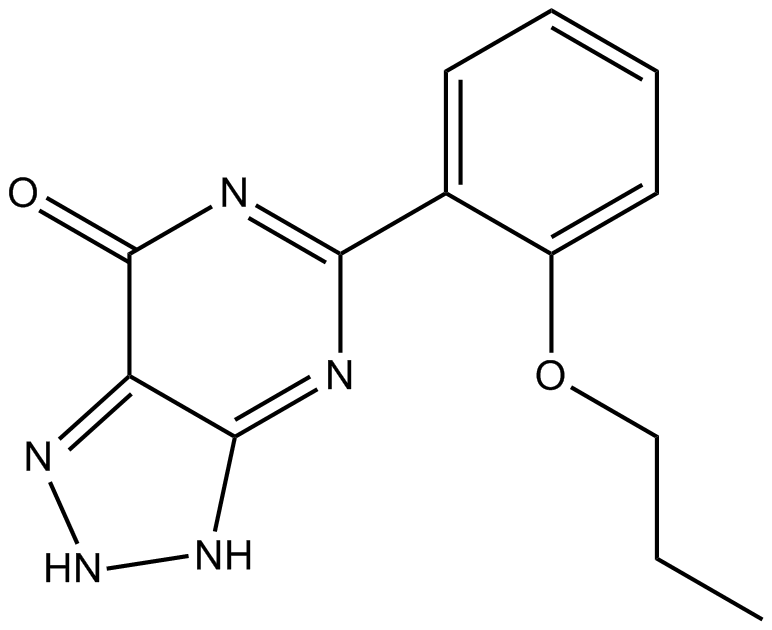Zaprinast (Synonyms: 2(oPropoxyphenyl)8azapurin6one, M&B 22,948) |
| Catalog No.GC12909 |
Zaprinast (M&B 22948) es un inhibidor de las fosfodiesterasas (PDE) selectivas de cGMP.
Products are for research use only. Not for human use. We do not sell to patients.

Cas No.: 37762-06-4
Sample solution is provided at 25 µL, 10mM.
IC50: 0.15, 0.76, 12.0 and 29.0 μM for PDE6, 5, 11 and 9 respectively.
Zaprinast is a phosphodiesterase inhibitor with selection for PDE6, 5, 11 and 9[1].
Several isoforms of phosphodiesterases (PDEs) can mediate their action of the diverse cellular and behavioral responses to these second messengers. Accordingly, these responses are modulated by the rates of synthesis of cyclic nucleotides by cyclases as well as their degradation by PDEs to biologically inactive 59 monophosphate nucleosides.
In vitro: Zaprinast is a PDE5 and PDE6 inhibitor with inhibiting PDE9 at moderately high concentrations (29 mM) [1]. Indeed, it showed that inhibition of cGMP hydrolysis by infusion of zaprinast increases the effect of ANP on natriuresis with no causing deleterious drops in blood pressure. Because it was known that ANP receptors is localized within the glomerulus and inner medullary collecting ducts, to determine the cellular localization of PDE9 enzyme in kidney will be interesting. [2]. The enzyme displayed a high specificity for cGMP with binding sites for cGMP, and a sensitivity to zaprinast similar to smooth muscle PDE5, resulting in both enzymes were named cGMP-PDE. However, retinal cGMP-PDE was first distinguished as photoreceptor cGMP-PDE with being specifically distributed in the retina and having a higher Vmax and Km values than other cGMP-PDEs and being modulated by G protein. [3].
In vivo: So far, no study in vivo has been conducted.
Clinical trial: So far, no clinical study has been conducted.
References:
[1] Christensen and Torphy (1994) Isozyme-selective phosphodiesterase inhibitors as antiasthmatic agents. Annu.Rep.Med.Chem. 29 185.
[2] Soderling SH, Bayuga SJ, Beavo JA. Identification and characterization of a novel family of cyclic nucleotide phosphodiesterases. J Biol Chem. 1998 Jun 19; 273(25):15553-8.
[3]. Lugnier C. Cyclic nucleotide phosphodiesterase (PDE) superfamily: a new target for the development of specific therapeutic agents. Pharmacol Ther. 2006 Mar; 109 (3):366-98. Epub 2005 Aug 15.
Average Rating: 5 (Based on Reviews and 9 reference(s) in Google Scholar.)
GLPBIO products are for RESEARCH USE ONLY. Please make sure your review or question is research based.
Required fields are marked with *




















